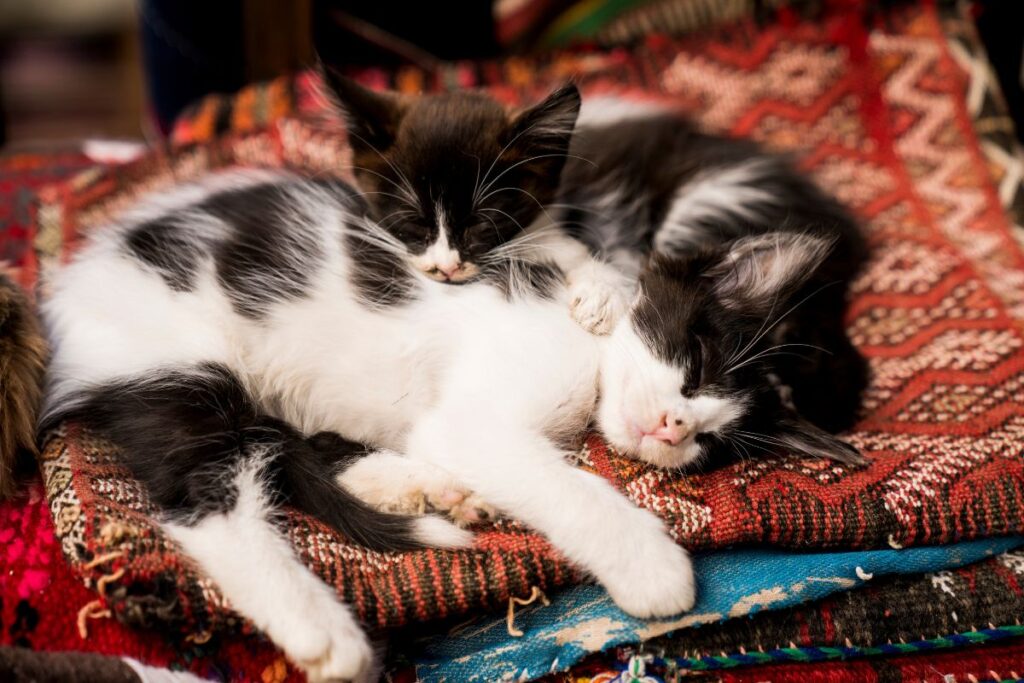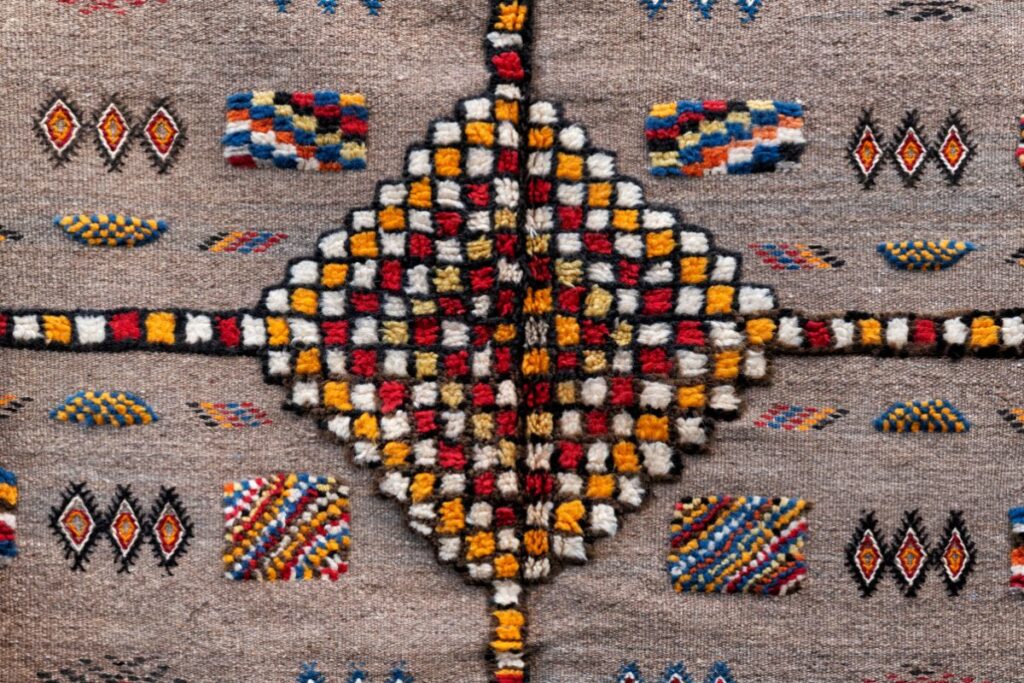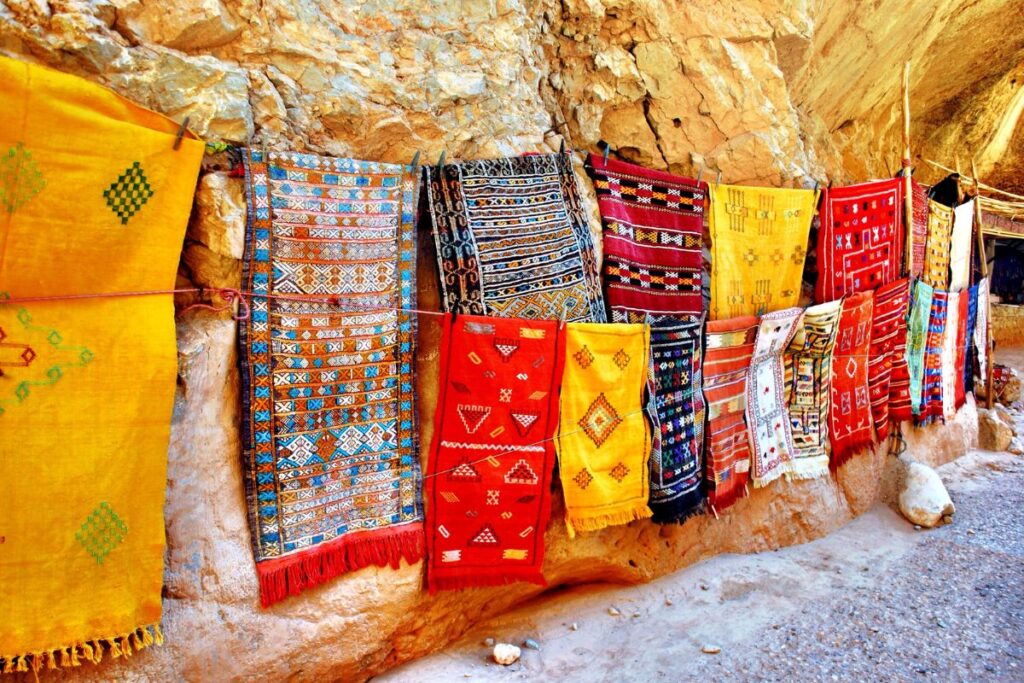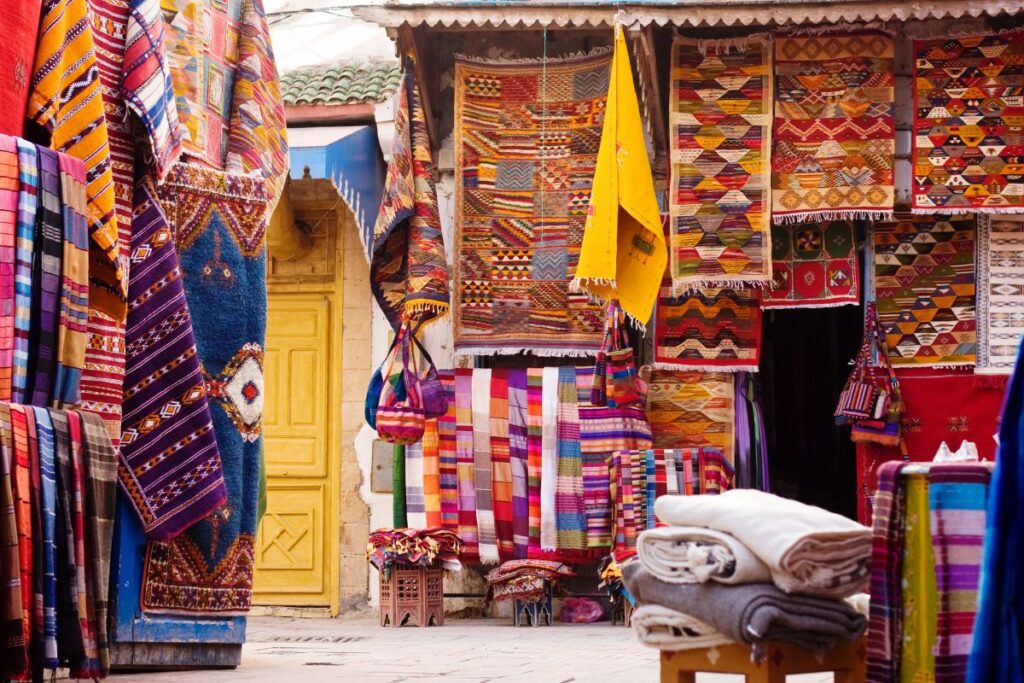Buying Moroccan carpets and rugs in Morocco is an attraction for tourists and a livelihood for thousands and thousands of people in the country. All the traditional crafts, which produce objects of daily life, are kept alive, which is one of the country’s great attractions. This can be seen in the medinas, where large souks are dedicated to selling this type of utensils. This article will provide information on the primary artisanal goods you can purchase when visiting Morocco.
Carpets in Morocco, the main product

Carpets, in Morocco, are much more than just a simple item to cover the floor. They are authentic works of art. You will find them in practically every city, although there are places specialized in different techniques and styles. Broadly speaking, we can speak of the peasant or Berber in the Middle Atlas and the coarser carpets of Northern Morocco (Rabat, Tetouan, Chaouen, etc.) with a wealth of colors. But the most prestigious are those of Fes, embroidered in silk, linen, cotton, satin and gold threads.
Rugs in Morocco

Rugs in Morocco are a highly sought-after product, valued for their quality craftsmanship and unique designs. Made using traditional weaving techniques, these rugs are handcrafted by skilled artisans using high-quality wool sourced from different regions in Morocco. They come in various sizes, colors, and patterns and are often used as decorative pieces in homes and businesses worldwide. Moroccan rugs have gained global popularity due to their durability, intricate designs, and cultural significance. As such, they are an important export product for Morocco and play an important role in its economy.
The difference between Moroccan carpets and rugs
The main difference between Moroccan carpets and rugs in Morocco is their size and intended use. Carpets are typically larger and used as floor coverings, while rugs are smaller and often used as decorative pieces. They are also usually made using a different weaving technique than rugs, which results in a thicker and more plush texture. Additionally, Moroccan carpets often feature more intricate patterns and designs than rugs and are made using high-quality wool sourced from specific regions in Morocco. Both carpets and rugs are highly valued for their craftsmanship and beauty and are an important part of Moroccan culture and tradition.
Jewelry, the Moroccan luxury
Many are also jewels that can be bought on the street in Morocco. Jewelers in many cities occupy the same neighborhoods as centuries ago, which adds tourist attraction. In cities like Marrakech, Essaouira, Fes or Rabat, you will find beautiful productions of gold, silver and precious stones, while in Berber areas, only silver is worked.
Leather, a tradition in itself

Another flagship of Moroccan craftsmanship is leather. Therefore, in our country, we speak of ‘leather goods’ when we refer to works made in leather. The proposals have gained in sophistication and variety in recent years, going from simple saddles and slippers to a large catalog of poufs, bags, suitcases, belts and even clothing such as jackets.
Basketry, the art of everyday life
Basketry is the opposite of jewelry. It creates everyday items, nothing luxurious. But their originality attracts the attention of many tourists, making them an interesting travel souvenir. Reed, reeds and dwarf palm trees are used to create garden furniture, baskets and even lamps, among other objects.
Ceramics: decoration and utility

We close this review of the five major specialties of Moroccan craftsmanship with ceramics, which is also deeply rooted in the country’s daily life. A distinction is made between decorative ceramics and ceramics for utilitarian purposes. The blue productions of Fes, the brown, green and yellow ones of Safi and the glazed earthenware of Azemmur, Marrakech, Meknes or Rabat, among others, stand out.
If you want to organize a cultural trip with this theme as a protagonist, contact Idealmoroccotours, and we will design a route to get the country’s best pieces!
What is the history of Moroccan rugs and carpets?
Moroccan carpets and rugs have a long history dating back to ancient times. The Berber people of Morocco have been weaving carpets and rugs for centuries, using natural fibers and dyes.
What materials are used to make Moroccan rugs and carpets?
They are typically made from natural wool, camel hair, and cotton fibers. They are often dyed using natural materials such as henna, saffron, and indigo.
What is the difference between a carpet and a rug in Morocco?
In Morocco, “carpet” and “rug” are often used interchangeably. However, carpets are usually larger and used to cover a larger area of the floor, while rugs are smaller and used to cover specific areas.
Where can I buy authentic Moroccan carpets and rugs?
You can find authentic Moroccan carpets and rugs in Moroccan cities’ souks (markets) such as Marrakech, Fes, and Rabat. Be prepared to bargain with the vendors to get a fair price.
How do I know if a Moroccan carpet or rug is authentic?
Authentic Moroccan carpets and rugs are handmade and feature unique designs and patterns. Look for imperfections and inconsistencies in the weave, which can signify a handmade product.
How do I care for my Moroccan carpet or rug?
Regular vacuuming and occasional professional cleaning can help keep your Moroccan carpet or rug in good condition. Be sure to check the care instructions for your specific carpet or rug.
What is the average price of a Moroccan carpet or rug?
The price of a Moroccan carpet or rug can vary widely depending on the design’s size, quality, and complexity. Expect to pay anywhere from a few hundred to several thousand dollars for an authentic Moroccan carpet or rug.
Can I ship a Moroccan carpet or rug to my home country?
Yes, many vendors in Morocco can arrange to have your carpet or rug shipped to your home country. Be sure to factor in shipping costs and applicable taxes or customs fees.
How long does it take to make a Moroccan carpet or rug?
The time it takes to make a Moroccan carpet or rug depends on the size and complexity of the design. A small rug might take a few weeks to make, while a large carpet with a complex pattern might take several months.
Are Moroccan carpets and rugs a good investment?
Authentic Moroccan carpets and rugs are handmade and often feature unique designs, making them a good investment for those who appreciate handmade crafts and want to add a unique touch to their home decor. However, like any investment, the value can fluctuate over time.

